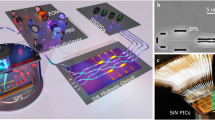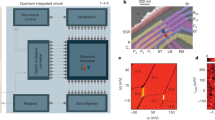Abstract
Integrated nanophotonic devices create strong light–matter interactions that are important for the development of solid-state quantum networks1, distributed quantum computers2 and ultralow-power optoelectronics3,4. A key component for many of these applications is the photonic quantum logic gate, where the quantum state of a solid-state quantum bit (qubit) conditionally controls the state of a photonic qubit. These gates are crucial for the development of robust quantum networks5,6,7, non-destructive quantum measurements8,9 and strong photon–photon interactions10. Here, we experimentally realize a quantum logic gate between an optical photon and a solid-state qubit. The qubit is composed of a quantum dot strongly coupled to a nanocavity, which acts as a coherently controllable qubit system that conditionally flips the polarization of a photon on picosecond timescales, implementing a controlled-NOT gate. Our results represent an important step towards solid-state quantum networks and provide a versatile approach for probing quantum dot–photon interactions on ultrafast timescales.
This is a preview of subscription content, access via your institution
Access options
Subscribe to this journal
Receive 12 print issues and online access
$209.00 per year
only $17.42 per issue
Buy this article
- Purchase on Springer Link
- Instant access to full article PDF
Prices may be subject to local taxes which are calculated during checkout




Similar content being viewed by others
References
Cirac, J. I., Zoller, P., Kimble, H. J. & Mabuchi, H. Quantum state transfer and entanglement distribution among distant nodes in a quantum network. Phys. Rev. Lett. 78, 3221–3224 (1997).
Raussendorf, R. & Briegel, H. J. A one-way quantum computer. Phys. Rev. Lett. 86, 5188–5191 (2001).
Chang, D. E., Sorensen, A. S., Demler, E. A. & Lukin, M. D. A single-photon transistor using nanoscale surface plasmons. Nature Phys. 3, 807–812 (2007).
Hwang, J. et al. A single-molecule optical transistor. Nature 460, 76–80 (2009).
Childress, L., Taylor, J. M., Sørensen, A. S. & Lukin, M. D. Fault-tolerant quantum communication based on solid-state photon emitters. Phys. Rev. Lett. 96, 070504 (2006).
Waks, E. & Vuckovic, J. Dipole induced transparency in drop-filter cavity–waveguide systems. Phys. Rev. Lett. 96, 153601 (2006).
Van Loock, P. et al. Hybrid quantum repeater using bright coherent light. Phys. Rev. Lett. 96, 240501 (2006).
Rauschenbeutel, A. et al. Coherent operation of a tunable quantum phase gate in cavity QED. Phys. Rev. Lett. 83, 5166–5169 (1999).
Volz, J., Gehr, R., Dubois, G., Esteve, J. & Reichel, J. Measurement of the internal state of a single atom without energy exchange. Nature 475, 210–213 (2011).
Duan, L. M. & Kimble, H. J. Scalable photonic quantum computation through cavity-assisted interactions. Phys. Rev. Lett. 92, 127902 (2004).
Stievater, T. H. et al. Rabi oscillations of excitons in single quantum dots. Phys. Rev. Lett. 87, 133603 (2001).
Press, D., Ladd, T. D., Zhang, B. & Yamamoto, Y. Complete quantum control of a single quantum dot spin using ultrafast optical pulses. Nature 456, 218–221 (2008).
Xu, X. et al. Optically controlled locking of the nuclear field via coherent dark-state spectroscopy. Nature 459, 1105–1109 (2009).
Latta, C. et al. Confluence of resonant laser excitation and bidirectional quantum-dot nuclear-spin polarization. Nature Phys. 5, 758–763 (2009).
Brunner, D. et al. A coherent single-hole spin in a semiconductor. Science 325, 70–72 (2009).
Vamivakas, A. N. et al. Observation of spin-dependent quantum jumps via quantum dot resonance fluorescence. Nature 467, 297–300 (2010).
Li, X. et al. An all-optical quantum gate in a semiconductor quantum dot. Science 301, 809–811 (2003).
Kim, D., Carter, S. G., Greilich, A., Bracker, A. S. & Gammon, D. Ultrafast optical control of entanglement between two quantum-dot spins. Nature Phys. 7, 223–229 (2011).
Reithmaier, J. P. et al. Strong coupling in a single quantum dot–semiconductor microcavity system. Nature 432, 197–200 (2004).
Yoshie, T. et al. Vacuum Rabi splitting with a single quantum dot in a photonic crystal nanocavity. Nature 432, 200–203 (2004).
Peter, E. et al. Exciton–photon strong-coupling regime for a single quantum dot embedded in a microcavity. Phys. Rev. Lett. 95, 067401 (2005).
Hennessy, K. et al. Quantum nature of a strongly coupled single quantum dot–cavity system. Nature 445, 896–899 (2007).
Englund, D. et al. Controlling cavity reflectivity with a single quantum dot. Nature 450, 857–861 (2007).
Srinivasan, K. & Painter, O. Linear and nonlinear optical spectroscopy of a strongly coupled microdisk–quantum dot system. Nature 450, 862–865 (2007).
Reitzenstein, S. et al. Exciton spin state mediated photon–photon coupling in a strongly coupled quantum dot microcavity system. Phys. Rev. B 82, 121306 (2010).
Förstner, J., Weber, C., Danckwerts, J. & Knorr, A. Phonon-assisted damping of Rabi oscillations in semiconductor quantum dots. Phys. Rev. Lett. 91, 127401 (2003).
Ramsay, A. J. A review of the coherent optical control of the exciton and spin states of semiconductor quantum dots. Semicond. Sci. Technol. 25, 103001 (2010).
Ohta, R. et al. Strong coupling between a photonic crystal nanobeam cavity and a single quantum dot. Appl. Phys. Lett. 98, 173104 (2011).
Bose, R., Sridharan, D., Solomon, G. S. & Waks, E. Observation of strong coupling through transmission modification of a cavity-coupled photonic crystal waveguide. Opt. Express 19, 5398–5409 (2011).
Faraon, A., Majumdar, A., Kim, H., Petroff, P. & Vučković, J. Fast electrical control of a quantum dot strongly coupled to a photonic-crystal cavity. Phys. Rev. Lett. 104, 047402 (2010).
Bose, R., Sridharan, D., Solomon, G. S. & Waks, E. Large optical Stark shifts in semiconductor quantum dots coupled to photonic crystal cavities. Appl. Phys. Lett. 98, 121109 (2011).
Acknowledgements
The authors acknowledge support from the Army Research Office Multidisciplinary University Research Initiative on hybrid quantum interactions (grant no. W911NF09104), a Defense Advanced Research Projects Agency (DARPA) Defense Science Office grant (grant no. W31P4Q0910013), the Physics Frontier Center at the Joint Quantum Institute, and the Office of Naval Research Applied Electromagnetics Center. E.W. acknowledges support from the National Science Foundation Faculty Early Career Development (CAREER) award (grant no. ECCS 0846494) and a DARPA Young Faculty Award (grant no. N660011114121).
Author information
Authors and Affiliations
Contributions
H.K. and E.W. conceived and designed the experiment, and prepared the manuscript. H.K. carried out the measurements and analysed the data. R.B. and T.C.S. contributed to the measurements and sample design. E.W. and H.K. carried out the theoretical analysis. G.S.S. provided samples grown by molecular beam epitaxy.
Corresponding author
Ethics declarations
Competing interests
The authors declare no competing financial interests.
Supplementary information
Supplementary information
Supplementary information (PDF 2358 kb)
Rights and permissions
About this article
Cite this article
Kim, H., Bose, R., Shen, T. et al. A quantum logic gate between a solid-state quantum bit and a photon. Nature Photon 7, 373–377 (2013). https://doi.org/10.1038/nphoton.2013.48
Received:
Accepted:
Published:
Issue Date:
DOI: https://doi.org/10.1038/nphoton.2013.48
This article is cited by
-
Giant optical polarisation rotations induced by a single quantum dot spin
Nature Communications (2024)
-
On-chip spin-photon entanglement based on photon-scattering of a quantum dot
npj Quantum Information (2023)
-
Integrated photonic platforms for quantum technology: a review
ISSS Journal of Micro and Smart Systems (2023)
-
Ancilla-assisted protection of information: application to atom–cavity systems
Quantum Information Processing (2023)
-
Strong coupling between a plasmon mode and multiple different exciton states
Science China Physics, Mechanics & Astronomy (2023)



